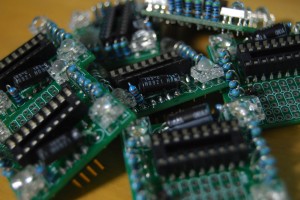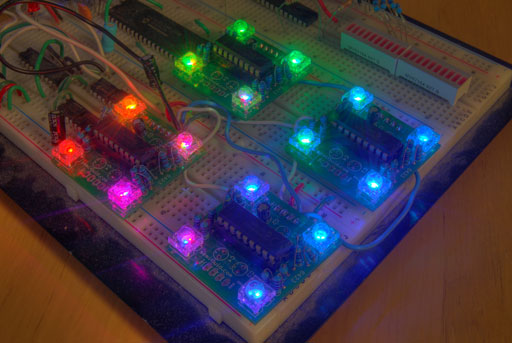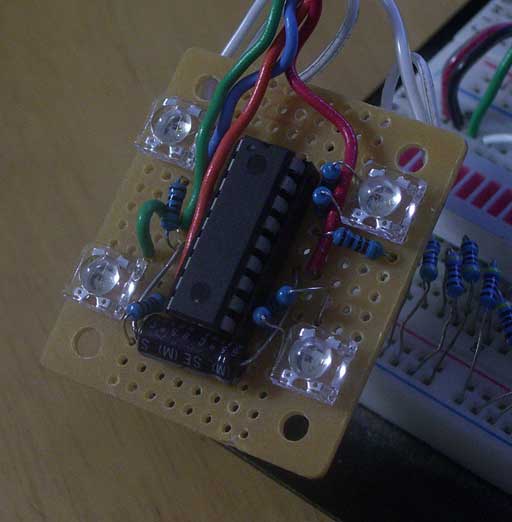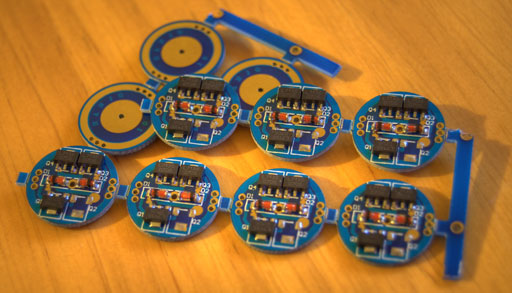So, this project was sidelined until I had to make another BatchPCB purchase. Thankfully it wasn’t too long until I had the opportunity to work on it again! The current setup is basically 4 of the original 4 RGB LED Controller boards and 12 of the updated DR1r3 boards. All 16 are wired in parallel and being controlled by my desktop machine. You can see an extended version of this RGB test sequence after the break and I’m also including the (uncommented, sorry!) Processing 1.1 code that I used to control the boards.
Category: LEDs
4 RGB LED Controller Update
I recently began working on a consulting project that required the creation of some PCBs. Since I have had such great success with BatchPCB.com in the past, I decided to use them again to fab the custom PCBs. The BatchPCB purchasing system adds a few static fees (set-up, handling, and shipping), so I felt that this was as good a time as any to make some additional of my PIC16F628 4 RGB LED PWM Controller boards with a couple of modifications.
PIC16F628 4 RGB LED PWM Controller
I am a big fan of LEDs. Bright, colorful, flashing LEDs. So, given my affinity for LEDs, I decided to work on a controller that me and a few of my friends could use as an art project/passive information display. I have posted videos from the first prototypes (here and here), but it has been tough to dedicate time to further development given my research, so I thought I would post the information so that anyone can take the design and modify it to their liking!
PIC16F628 Serial 4 LED PWM DR1r6
I’ve been working on a project in my spare time with two friends to create some ambient light controllers, so I thought I’d just post two short videos to demonstrate the current state of the project. In the current iteration, they can be used as wall-washers or they can be enclosed to create ambient light cubes/spheres/pentagonal cupolas/rhombo-hexagonal dodecahedrons/etc. Each module is addressable and uses a PIC16F628 to control each of the RGB LEDs (which were purchased from the eBay seller jeledhk with the description “Superflux RGB 5mm R/H LEDLamp 8Kmcd COMMON CATHODE”). The PCBs were created using BatchPCB.com for $5 each (+ ~$15 total for S&H and setup) and are beautifully etched, drilled, and silkscreened (although it took about 1.5 months to receive them). Ok, less talk, more videos; one video on the front page and another after the jump:
PIC16F628 Serial 4 LED PWM
It has been a long time since I’ve done any microcontroller work, so I decided to get back into the swing of things when 2 of my friends and I decided on collaborating on an interactive “art” piece. Details are forthcoming, but in the meantime, a photo and a video of one of the LED components (video after the break):
AMC7135 Driver Boards & Luxeon K2s
I know it’s been a looooong time since I’ve posted any new electronics projects, but that’s primarily been due to my increased course load now that I’m in graduate school. Well, I’ve finally picked up some 1050 ma constant current driver boards for the Luxeon K2 LEDs that I mentioned a while ago and hopefully I’ll get these up and running in just a little bit. I just wanted to post some pictures because I think they’re nice little boards.
Royal Blue Luxeon K2
 Lowe’s had a 1 Watt Luxeon Plastic Flashlight on sale for $2.50 recently. I ordered one online for in-store pickup and was able to get one of the last flashlights available at the store closest to me (they actually didn’t have enough to fulfill all of the orders, but I was able to convince them that I deserved one). When I brought it home and broke it open I found a nice white 1 watt Luxeon star hex (LXHL-MW1D) bolted to the top. The flashlight itself felt relatively cheap and flimsy, so I decided to find out what I would do with it and how I could modify it. The flashlight used 3 1.5V AA batteries in series (i.e. 4.5V open circuit) and had a 1 Ohm resistor in series to limit the current to the LED. White flashlights are nice, but sometimes you need to just have fun. So, I took one of the Luxeon K2 Royal Blue LEDs (LXK2-PR12-L00) that I had purchased with Matt Kocsis and dropped it in. Read More
Lowe’s had a 1 Watt Luxeon Plastic Flashlight on sale for $2.50 recently. I ordered one online for in-store pickup and was able to get one of the last flashlights available at the store closest to me (they actually didn’t have enough to fulfill all of the orders, but I was able to convince them that I deserved one). When I brought it home and broke it open I found a nice white 1 watt Luxeon star hex (LXHL-MW1D) bolted to the top. The flashlight itself felt relatively cheap and flimsy, so I decided to find out what I would do with it and how I could modify it. The flashlight used 3 1.5V AA batteries in series (i.e. 4.5V open circuit) and had a 1 Ohm resistor in series to limit the current to the LED. White flashlights are nice, but sometimes you need to just have fun. So, I took one of the Luxeon K2 Royal Blue LEDs (LXK2-PR12-L00) that I had purchased with Matt Kocsis and dropped it in. Read More
Luxeon K2 LED show-off
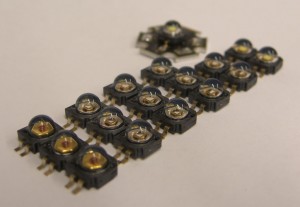 A friend (Matt Kocsis) and I purchased some Luxeon K2 LED emitters from Lumileds and I’m looking forward to building some constant current PWM drivers for them. I’ve found a couple of constant current driver schematics, but I’m planning on pulsing the outputs (which can draw up to 1.5A), so I want to make sure that the circuits will work with the high-frequency PWM. Matt and I are also working on a heatsink that will effectively cool these LEDs. The plan is to create a programmable high-intensity RGB spot/wash light with pan/tilt and optic (i.e. focus) control. We’ll see how this project pans out, but in the meantime, playing with these incredibly high intensity LEDs has been quite fun. Read More
A friend (Matt Kocsis) and I purchased some Luxeon K2 LED emitters from Lumileds and I’m looking forward to building some constant current PWM drivers for them. I’ve found a couple of constant current driver schematics, but I’m planning on pulsing the outputs (which can draw up to 1.5A), so I want to make sure that the circuits will work with the high-frequency PWM. Matt and I are also working on a heatsink that will effectively cool these LEDs. The plan is to create a programmable high-intensity RGB spot/wash light with pan/tilt and optic (i.e. focus) control. We’ll see how this project pans out, but in the meantime, playing with these incredibly high intensity LEDs has been quite fun. Read More
